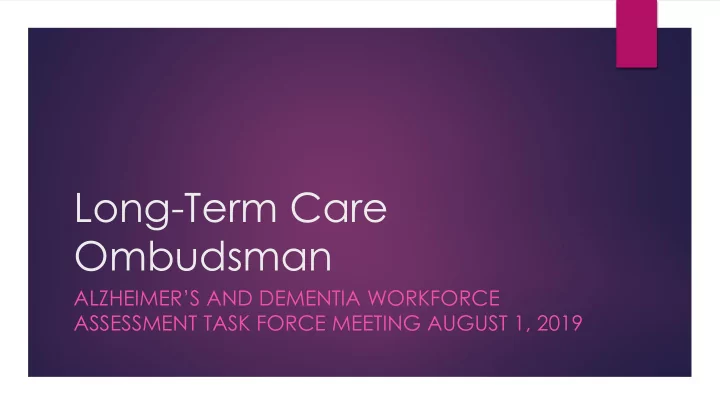

Long-Term Care Ombudsman ALZHEIMER’S AND DEMENTIA WORKFORCE ASSESSMENT TASK FORCE MEETING AUGUST 1, 2019
What’s a Long -Term Care Ombudsman? A Long-Term Care Ombudsman is a resident advocate. Ombudsmen advocate for quality of care and quality of life of residents in long-term care. Ombudsman provisions in the Older Americans Act (OAA) include: Investigate and resolve complaints Provide information to residents, families, staff (e.g. residents’ rights) Advocate for systemic changes to improve residents’ care and quality of life.
The Ombudsman and Staffing In FFY 2018, Kentucky’s Ombudsmen investigated 6,025 complaints Complaints about care represent 27% of all complaints “Failure to respond to requests for assistance” represent 8% of all complaints Complaints about staff represent 15% of all complaints “Dignity, respect, & staff attitudes” represent 5% of complaints “Shortage of staff” represents 3% of all complaints “Staff training & turnover” represents 1.5% of complaints “Retaliation” represents 1% of complaints
Residents and Staffing Representative Deanna Frazer, James Musser, and DAIL Commissioner Shannon Gadd visited two nursing homes with Bluegrass District Ombudsman Denise Wells and 2 facility ombudsmen.
Residents and Staffing Residents told us exactly what happens when there’s not enough staff One resident responds to residents she hears calling out for help One resident choked on her dinner and nearly died while her roommate searched for someone to help Nearly every resident told us there were not enough people in the building Residents reported many nurse aides did not have enough training and “don’t know what they’re doing.”
Priscilla
Did you know? One in four Americans will be aged 65 and older in 2060. More than half of this population will need long- term care at some point.
What is a Direct Care Worker (DCW) Direct care workers assist older adults and people with disabilities with daily tasks, such as dressing, bathing, and eating. Direct care workers include personal care aides, home health aides, and nursing assistants. Nursing assistants also perform clinical tasks, such as blood pressure readings and assistance with range-of-motion exercises.
Enhance Quality of Care in Residential Settings No matter what laws and regulations are in place, no matter if the care is from a for-profit or not-for-profit organization, no matter the amount of money being paid by the individual or by the State’s Medicaid program -- the experience of the older adult is determined by his or her interactions with the Direct Care Worker (DCW). Nursing home residents throughout the country explained that the most important elements of quality in their day-to-day lives were the accessibility and attitude of the DCW. A good long-term care experience is dependent on having enough DCWs who are well trained and have a positive attitude
KEY FACTS The direct care workforce totaled 4.3 million in 2017. The home care job is among the fastest-growing occupations and added 1 million jobs between 2016 and 2017 - more than any other single occupation Adjusted for inflation, wages for home care workers have remained stagnant in the last decade: $10.66 in 2007 and $11.30 in 2017. Nursing assistants are more than three times more likely to experience injuries on the job than the typical U.S. worker. One in four direct care workers is an immigrant - totaling 1 million nationwide.
Immigrants are a valuable part of the direct care workforce – both now and in the future Three ways long-term care leaders can support this segment of the workforce: IMMIGRANTS IN Generate new studies on this 1. sector DIRECT CARE Promote culturally and 2. linguistically competent workforce supports Form community partnerships 3. with immigrant-focused organizations
The typical direct care worker is a woman in her late 30s or early 40s.
Younger workers. The U.S. labor force includes 31 million younger workers aged 18 to 24. This demographic makes up 16 percent of the direct care workforce. 2 Expanding Older workers. Roughly one in four direct the Labor care workers is aged 55 and older, many of whom bring significant work and life experience to these roles. 3 Pool Men. Men make up roughly half of the U.S. labor force yet only 14 percent work in long-term care. Many men connect their experiences as family caregivers to direct care. 4
1. Recruit the Right Staff 2. Improve the Hiring Process 3. Strengthen Entry-Level Training 4. Provide Employment Supports Growing a 5. Promote Peer Support 6. Ensure Effective Supervision Strong Direct 7. Develop Advancement Opportunities Care 8. Invite Participation 9. Recognize and Reward Staff Workforce 10. Measure Progress
Thank you Sherry Culp Kentucky State Long-Term Care Ombudsman sherryculp@ombuddy.org 859-277-9215 Denise Wells Bluegrass District Long-Term Care Ombudsman denise@Ombuddy.org 859-277-9215
Recommend
More recommend